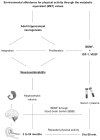Environmental Affordance for Physical Activity, Neurosustainability, and Brain Health: Quantifying the Built Environment's Ability to Sustain BDNF Release by Reaching Metabolic Equivalents (METs)
- PMID: 39595896
- PMCID: PMC11592236
- DOI: 10.3390/brainsci14111133
Environmental Affordance for Physical Activity, Neurosustainability, and Brain Health: Quantifying the Built Environment's Ability to Sustain BDNF Release by Reaching Metabolic Equivalents (METs)
Abstract
Background/Objectives: Unlike enriched environments for rodents, human-built environments often hinder neuroplasticity through sedentary lifestyles, to which exercise can merely overcome its adverse effects. This paper introduces "environmental affordance for physical activity" to quantify the potential of spatial layout designs to stimulate activity and sustain neuroplasticity, mainly hippocampal neurogenesis. Methods: A novel framework links metabolic equivalents (METs) that can be afforded by the spatial layout of the built environment to its role in increasing the brain-derived neurotrophic factor (BDNF)-a biomarker that promotes and sustains adult hippocampal neurogenesis and synaptic plasticity. Equations are developed to assess the built environment's affordance for physical activity through BDNF changes measurable after brief exposure to the built environment for 20-35 min. Results: The developed equations are evidenced to be feasible to cause BDNF release through low- to moderate-intensity physical activity. This model provides a feasible assessment tool to test the built environment's effectiveness towards neurosustainability. Conclusions: By sustaining neurogenesis, the environmental affordance for physical activity holds promise for improving mental health and preventing cognitive decline.
Keywords: architectural design; brain health and cognition; built environment; environmental enrichment; exercise; neuroplasticity; spatial layout.
Conflict of interest statement
The authors declare no conflict of interest.
Figures





Similar articles
-
Housing Environmental Enrichment, Lifestyles, and Public Health Indicators of Neurogenesis in Humans: A Pilot Study.Int J Environ Res Public Health. 2024 Nov 25;21(12):1553. doi: 10.3390/ijerph21121553. Int J Environ Res Public Health. 2024. PMID: 39767394 Free PMC article.
-
The Impact of Walking on BDNF as a Biomarker of Neuroplasticity: A Systematic Review.Brain Sci. 2025 Feb 27;15(3):254. doi: 10.3390/brainsci15030254. Brain Sci. 2025. PMID: 40149776 Free PMC article. Review.
-
The BDNF-Interactive Model for Sustainable Hippocampal Neurogenesis in Humans: Synergistic Effects of Environmentally-Mediated Physical Activity, Cognitive Stimulation, and Mindfulness.Int J Mol Sci. 2024 Dec 1;25(23):12924. doi: 10.3390/ijms252312924. Int J Mol Sci. 2024. PMID: 39684635 Free PMC article. Review.
-
Neurosustainability.Front Hum Neurosci. 2024 Aug 29;18:1436179. doi: 10.3389/fnhum.2024.1436179. eCollection 2024. Front Hum Neurosci. 2024. PMID: 39268220 Free PMC article.
-
Environmental enrichment: a systematic review on the effect of a changing spatial complexity on hippocampal neurogenesis and plasticity in rodents, with considerations for translation to urban and built environments for humans.Front Neurosci. 2024 Jun 11;18:1368411. doi: 10.3389/fnins.2024.1368411. eCollection 2024. Front Neurosci. 2024. PMID: 38919908 Free PMC article.
Cited by
-
Walking and Hippocampal Formation Volume Changes: A Systematic Review.Brain Sci. 2025 Jan 8;15(1):52. doi: 10.3390/brainsci15010052. Brain Sci. 2025. PMID: 39851420 Free PMC article. Review.
-
Architecturally Mediated Allostasis and Neurosustainability: A Proposed Theoretical Framework for the Impact of the Built Environment on Neurocognitive Health.Brain Sci. 2025 Feb 15;15(2):201. doi: 10.3390/brainsci15020201. Brain Sci. 2025. PMID: 40002534 Free PMC article.
-
Housing Environmental Enrichment, Lifestyles, and Public Health Indicators of Neurogenesis in Humans: A Pilot Study.Int J Environ Res Public Health. 2024 Nov 25;21(12):1553. doi: 10.3390/ijerph21121553. Int J Environ Res Public Health. 2024. PMID: 39767394 Free PMC article.
-
The Impact of Walking on BDNF as a Biomarker of Neuroplasticity: A Systematic Review.Brain Sci. 2025 Feb 27;15(3):254. doi: 10.3390/brainsci15030254. Brain Sci. 2025. PMID: 40149776 Free PMC article. Review.
-
The BDNF-Interactive Model for Sustainable Hippocampal Neurogenesis in Humans: Synergistic Effects of Environmentally-Mediated Physical Activity, Cognitive Stimulation, and Mindfulness.Int J Mol Sci. 2024 Dec 1;25(23):12924. doi: 10.3390/ijms252312924. Int J Mol Sci. 2024. PMID: 39684635 Free PMC article. Review.
References
-
- de Sousa Fernandes M.S., Ordônio T.F., Santos G.C.J., Santos L.E.R., Calazans C.T., Gomes D.A., Santos T.M. Effects of physical exercise on neuroplasticity and brain function: A systematic review in human and animal studies. Neural Plast. 2020;2020:8856621. doi: 10.1155/2020/8856621. - DOI - PMC - PubMed
-
- Lauretta G., Ravalli S., Maugeri G., D’Agata V., Rosa M.D., Musumeci G. The impact of physical exercise on the hippocampus in physiological condition and ageing-related decline: Current evidence from animal and human studies. Curr. Pharm. Biotechnol. 2022;23:180–189. doi: 10.2174/1389201022666210405142611. - DOI - PubMed
-
- Håkansson K., Ledreux A., Daffner K., Terjestam Y., Bergman P., Carlsson R., Mohammed A.K.H. BDNF responses in healthy older persons to 35 minutes of physical exercise, cognitive training, and mindfulness: Associations with working memory function. J. Alzheimer’s Dis. 2017;55:645–657. doi: 10.3233/JAD-160593. - DOI - PMC - PubMed
Grants and funding
LinkOut - more resources
Full Text Sources

